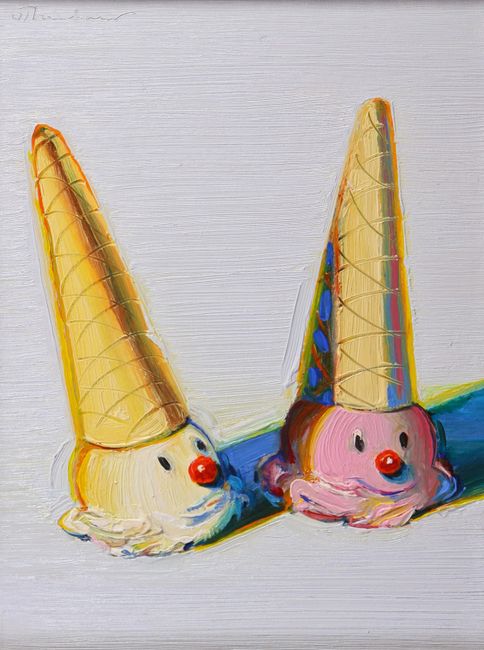
Jolly Cones
Wayne Thiebaud, Jolly Cones, 2002.
The original was created using oil on canvas.
"Common objects become strangely uncommon when removed from their context and ordinary ways of being seen."
~Wayne Thiebaud
Though born in Mesa, Arizona, Wayne Thiebaud has lived much of his life right here in Northern California. Thiebaud began his career as a commercial artist, including a short stint as a teen at Walt Disney Studios, before formally studying at San Jose State University. In the early 1950s he went to graduate school at (then) Sacramento State College and taught at Sacramento City College for nine years before moving on to U.C. Davis where he taught from 1960-2002!
Thiebaud is averse to labels such as ‘fine art’ versus ‘commercial art’ and has described himself as “just an old-fashioned painter.” Although often categorized under Pop Art, he admittedly dislikes Andy Warhol’s ”flat” and ”mechanical” paintings and does not count himself as a pop artist.
From 1956 to 1957 Thiebaud took a teaching sabbatical during which he worked on Madison Avenue in New York City, the center of the art world at that time. There he met many other art luminaries, and secured his place in the international art scene. Between 1960 and 1961, Thiebaud entered a new and exceptionally prolific phase of his practice, producing more than 100 paintings that depict objects of everyday American life — ranging from gumball machines to swimsuits and slices of pie — rendered with exaggerated colors reminiscent of commercial advertising. The following year he had a one-man exhibition featuring his still life paintings. This happened to be the moment the Pop Art movement captured the nation’s attention, and Thiebaud’s subjects were a confectioner’s delight.
With a bright palette, consumerist imagery, and graphic presentation, Thiebaud’s paintings were of the moment, but differed from Pop artists like Andy Warhol and Roy Lichtenstein. While they emphasized the methods and appearance of mechanical reproduction and were very linear in style, Thiebaud was a painterly practitioner, meaning he loosely applied paint and left his brushstrokes visible.
Depicting his subjects against clean white backgrounds, he outlines his forms with bands of rainbow color. His confections cast vibrant blue shadows, and the cool contrast this provides to the artificial colors of the sugary treats became a signature element of Thiebaud’s style.
Jolly Cones is a perfect example of how the sculptural qualities of Thiebaud’s impasto technique bring his objects to life. He paints his compositions much like a confectioner, using his brush and palette knife in the place of fondant tools and spatulas to shape and model his impasto. When standing in front of a Thiebaud painting, the viewer is always left hungry and wanting to reach out and lick the tasty, provocative treat!
What is your favorite tasty treat? Using whatever art supplies you have at home, paint, sculpt, collage or draw your favorite dessert. Be creative, art can truly be made from anything! If you have access to thick paint, experiment using the impasto technique. Make your frosting or ice cream good enough to eat!
*linear – Refers to a style that obtains its effects through line rather than color or light and in which the edges of forms are sharply defined. Figures are distinct from one another.
*painterly – Refers to the application of paint in a ‘loose’ or less than controlled manner, resulting in the appearance of visible brushstrokes. It is characterized by qualities of color, stroke, and texture rather than line.
*impasto – The texture produced by the thickness of pigment (paint) in a painting.
*palette knife – A palette knife is a blunt tool with a flexible steel blade used for mixing or applying paint. It is primarily utilized for mixing paint colors, paste, etc. Palette knives are useful for applying clean patches of color onto blank canvas or over an existing dry layer of paint. Palette knives may also be used directly on the painting surface to create both the illusion of texture and texture itself. This extra dimension emphasizes the lushness and physicality of the paint itself.
*pop art – Art which makes use of the imagery of consumerism and mass culture, with a finely balanced mixture of irony and celebration. Pop art began in the 1950s with various investigations into the nature of urban popular culture, notably by the members of the Independent Group at the ICA (Institute of Contemporary Arts) in London. Pop Art was at its height in the U.S. during the 1960s, where it came as a reaction to Abstract Expressionism and in fresh response to Dadaist notions. The basic concept was that mass-produced consumer goods were taken as the materials of a new art and a new aesthetic of expendability.
WAYNE THIEBAUD
For more information on the artist, visit
nga.gov/content/dam/ngaweb/Education/learning-resources/an-eye-for-art/AnEyeforArt-WayneThiebaud.pdf
Copyright © 2020 Emergency Art Museum - All Rights Reserved.
*The Emergency Art Museum claims no ownership, or copyright to any materials found here, or on-site. The Emergency Art Museum functions solely as a non-commercial, non-profit, educational resource for the community. All artwork represented or reproduced, has been done so for educational purposes only under the fair use act.
-Johnny DePalma, Owner / Curator
-Janelle Graves, Art Historian / Museum Educator